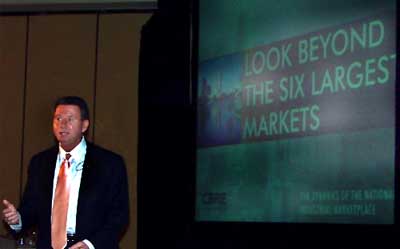verybody in this room has something to do with the rebound since 9/11.”
That’s how Jim Dieter, executive managing director for CB Richard Ellis, greeted a full house of continuous learners at the IAMC Professional Forum on Monday morning, March 21, as he prepared to explore with them the “Dynamics of the Industrial Marketplace.” He also took time to note the unsung hero status of most corporate real estate directors.
“The top salesperson gets his photo in the newsletter, and maybe a trip to Hawaii,” he said. And while the corporate real estate executive may have helped the company realize tremendous savings, he doesn’t get anything. “He just says, ‘Let’s move on to the next building,'” said Dieter.
With that Dieter moved on to an overview of the national and regional industrial markets. With average vacancy rates at 10 percent in a 12.7-billion-sq.-ft. market, lease rates are going down dramatically, but stabilizing. However, there are exceptions, he noted: New Jersey, Southern California and Toronto. He also noted similarities between recent absorption and vacancy rates and numbers in 1992-’93.
“Then absorption shot up,” he said. “It can happen
really quick, not a gradual development.”
Coming Into Focus
Looking at the nation’s six largest markets, Dieter
described the L.A. market as phenomenal, with vacancy rates at 2-2.5 percent.
“Everyone wants to be there,” he said, even though entitlement and environmental
challenges are still there: When one company goes to look for land there,
he said, it puts a budget together in anticipation of a lawsuit. “It’s
almost a  line
line
item,” he said. Add to that a political leadership that wants multifamily
and retail development, and the search for space can be challenging indeed.
While Chicago is stable, with most activity on the
periphery, Toronto is where a lot of action is unfolding. “Every major
U.S. developer has entered the Toronto marketplace,” he said, “or they’re
pinching themselves and saying, ‘I wish I had.'”
Meanwhile, Atlanta, the softest market on the continent, still has vacancy rates around 16 percent, but “the interesting thing,” said Dieter, “is that every major industrial developer is looking at Atlanta,” with growth happening nearer Hartsfield-Jackson International Airport rather than the formerly favored northeast sector of the metro.
Dallas is Dallas, said Dieter, noting that developers
just like to build there. And New Jersey is “where it’s all happening,”
driven in part by better port access for the larger container ships.
But the oft-scorned “flyover territory” of the U.S. mid-section is where even more interesting things are happening. Dieter identified Kansas City, Memphis and Indianapolis as important emerging growth markets, driven by rail access, FedEx growth and highway access in turn.
Other smaller markets now emerging include Tacoma, Wash., and Oakland, Calif., driven by port expansion. And the Pennsylvania cities of Harrisburg and Allentown (Lehigh Valley), despite challenging issues like unionization and dwindling land supply, are seeing improved activity, driven in part by developments like the intermodal facility in Chambersburg.
Other up-and-comers (some of which have been on a steady rise for some time) include the Baltimore-D.C. corridor, Savannah, Ga., and Tampa and Jacksonville, Fla. Again, port development is a common thread.
The No. 1 sign of an industrial market on the upswing?
“Developers are gaining land positions, and buying land like they

haven’t in a long time,” said Dieter.
They include AMB (“all over North America”), IDI (“bullish on Florida
and New Jersey”) and Panattoni (entered Toronto market, as well as St.
Louis). And despite the talk about increasingly large distribution buildings
especially, the hottest product is small buildings. Dieter also noted
that much development is being driven by institutional investment, in
some cases taking the form of a joint venture.
Why are things so active? Historically low cap rates, for one, said Dieter, between 6 percent and 7 percent. In addition, a scarcity of Class A product and a surplus of capital are fueling development.
Among the trends Dieter sees on the horizon is a continuing tendency for projects to be consumer-focused. The foreign automotive manufacturing sector will drive a healthy part of manufacturing investment. Build-to-suit will experience a resurgence. Smaller markets will get bigger on the radar. Speed to market will drive growth in air freight-oriented projects. But arching over all these trends is a fundamental shift.
“The past was consolidation,” he told the IAMC audience.
“This year will include expansion.” 